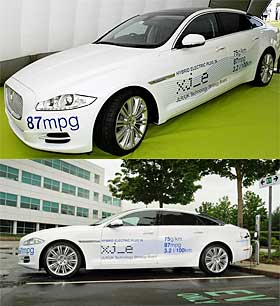Jaguar XJ_E Plug-in Hybrid
The Jaguar XJ_e is a prototype plug-in hybrid that was launched
to at least partially replace diesel engines as far as fuel
consumption and performance are concerned. Jaguar feels that
this new vehicle could in fact replace their 5.0 V8 engine.
The issue is that this may not be easily accomplished anytime
soon, with any great success.
Today's hybrids have been steadily evolving from vehicles for
urban families to those that are luxury sedans. It's not easy
to compare the comfort of a traditional V8 engine in a spacious
sedan to the hybrid engines that might eventually replace it.
Jaguar would prefer not to fall behind, especially since many
major brands already have hybrids beyond the prototype stage.
If the Jaguar XL is to have a hybrid model, it should complement
the power from the range of the 275 and 510 gasoline and diesel
horsepower.
Jaguar as a company does believe that sometime in the future,
mechanical hybrids with four-cylinder diesel engines could replace
the V8. A 2.0 4-cylinder gas engine with turbocharged power
and direct fuel injection is used now in Range Rover's Evoque,
and this will be the heart of the new Jaguar XJ_e, as well.
The motor is now used in the Evoque with an 8-speed automatic
transmission. The new aspect would be an electric motor that
connects to a battery pack with about half the power of the
one found in the Nissan Leaf.
The hybrid plug-in can be recharged in any 220 volt outlet,
and the XJ_e would consume about 3.2 liters per 100 kilometers',
with a much lower emissions rate while using maximum electrical
power. The performance of the Jaguar XJ_e is not poor. You can
go from zero to 100 km per hour in six and a half seconds, which
is less than it takes the 275 CV diesel to make the same 100
km per hour. The top speed of the new Jaguar is limited electronically
to 250 km/hr.
Even though the XJ_e is a prototype model, it not unlike the
Range Rover that has been seen in the past few years. But from
the looks of the competition, Jaguar will need to push their
hybrid model to production, if it wants to compete with companies
like Audi, which has already released the A8 hybrid.
Jaguar's XJ_e has been designed to help in the development
of the company's low-carbon, best in class premium vehicles.
The vehicle follows research from other hybrids like the Range_e
and Limo Green vehicles. It's an experimental model of the luxury
XJ sedan, and Jaguar is using the vehicle to demonstrate how
a parallel plug-in type hybrid can deliver lower C02 emissions
without having less performance ability.
The XJ_e is powered by a lithium iron phosphate Axeon battery.
The system uses a motor/generator combination and a lithium
iron based battery pack, which you can fully charge by using
a 240-volt power source for about four hours.
Having a parallel design allows the XJ_e to run on electricity,
gas or a combination of these two. The car possesses an intelligent
system to manage energy, and this system determines the most
efficient mode to use at any given time, allowing you to increase
your mileage and reduce your carbon footprint.
|

